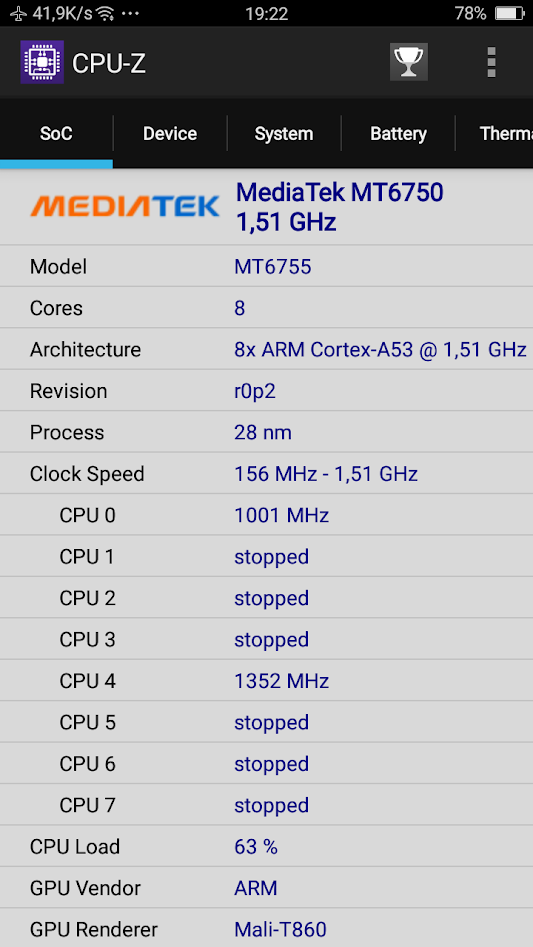Comparing: AMD A6-3400M vs MediaTek MT6750
In this comparison, we analyze two Processors: AMD A6-3400M and MediaTek MT6750, using synthetic benchmark tests to evaluate their overall performance. This side-by-side comparison helps users understand which hardware delivers better value, speed, and efficiency based on standardized testing. Whether you're building a new system or upgrading an existing one, this benchmark-driven evaluation offers valuable insights to guide your decision.

MediaTek MT6750
| Type: | Processors |
|---|---|
| Brand: | MediaTek |
| Model: | MediaTek MT6750 |
Specification Comparison Table
This specification comparison presents technical details of several devices or components to help you understand the key differences between each option. Use this table as a reference to determine which device best suits your needs.
| Specification | AMD A6-3400M | MediaTek MT6750 |
|---|---|---|
| Architecture | x86 | ARM |
| Technology | 32 nm | 28 nm |
| Clock | 1.4 GHz - 2.3 GHz | 1 GHz - 1.5 GHz |
| Core/Thread | 4 / 4 | 8 / 8 |
| Segmen | Mobile | Mobile |
Submission Comparison Table
This submission comparison table displays the number and details of benchmark data submissions from various devices or components. This information helps you understand the performance based on the benchmarks that have been tested, as well as providing an overview of the consistency and popularity of the available benchmark results.
| No. | Benchmark Software | AMD A6-3400M | MediaTek MT6750 |
|---|---|---|---|
| 1 | Geekbench3 - Multi Core |
2861 points |
1999 marks |
| 2 | Geekbench3 - Single Core |
803 points |
602 marks |
| 3 | Geekbench4 - Multi Core |
3119 points |
2594 marks |
| 4 | Geekbench4 - Single Core |
1060 points |
665 marks |
Submission Comparison Chart
This chart visualizes the benchmark scores comparison between two hardware devices based on submitted data.
Media Gallery
A collection of photos of tested hardware. These images can help you identify the physical form, model, and variant of the hardware in question. These photos are from our own documentation, and if they are not available we may not be able to document them.
About Hardware AMD A6-3400M
Released in mid-2011, the AMD A6-3400M is a mobile processor from the Llano family designed for the mid-range laptop segment. It has 4 cores and 4 threads with a base speed of 1.4 GHz that can increase to 2.3 GHz thanks to AMD's Turbo Core technology. Carrying a 32nm fabrication process, the A6-3400M offers good power efficiency with a TDP of 35W, making it a popular choice among conventional laptop users at the time. The main advantage of this processor lies not only in having enough cores for light multitasking, but also in the integration of an onboard GPU, the AMD Radeon HD 6520G. This GPU has 320 shader cores based on the Terascale 2 architecture, which is capable enough to run light graphics applications to older games with low resolution and graphics quality settings. The combination of CPU and GPU in one chip is designed to provide a balance between computing and graphics performance in one energy-efficient package.
In terms of performance, the A6-3400M can handle everyday computing needs such as browsing the internet, watching videos, listening to music, typing documents, and other light productivity tasks. However, in heavier usage scenarios or multitasking with many applications open at once, its performance starts to show limitations, especially when combined with a small RAM capacity such as 2GB. When compared to the same generation of Intel Core i3 processors, the A6-3400M does lag behind in single-thread performance, which is an important aspect for running modern applications that are not fully optimized for multi-core. In tests on a Lenovo Sabine B475 device with 2GB DDR3 RAM and Windows 7 operating system, the A6-3400M's performance showed that it is still quite responsive for light use, although it is no longer ideal for today's heavier workloads. Even so, the A6-3400M is still an attractive option for users who want a budget laptop with basic multimedia capabilities and a decent user experience for everyday needs.
Hardware Tested:
Device: Lenovo Sabine B475
RAM: 2GB DDR3
OS: Windows 7
Thursday, 24 November 2022 05:29:20 | Update: 1 month ago
About Hardware MediaTek MT6750
The MediaTek MT6750 is a mid-range mobile System-on-Chip (SoC) released in 2016, commonly found in budget-friendly Android smartphones. It features an octa-core CPU based on the ARM Cortex-A53 architecture, arranged in a big.LITTLE configuration — 4 cores clocked at 1.5 GHz for performance tasks and 4 cores at 1.0 GHz for power efficiency.
Manufactured using the 28nm process, the MT6750 supports a range of mid-tier features such as HD (720p) display output, up to 16MP camera support, and 4G LTE Cat. 6 connectivity. While adequate at the time of release, the 28nm node results in higher power consumption and less efficiency compared to newer SoCs built on smaller processes like 12nm or 7nm.
The integrated Mali-T860 MP2 GPU offers modest graphical performance, capable of handling light gaming, video playback, and everyday apps like messaging and browsing at low to medium graphics settings.
While not designed for heavy multitasking or modern games, the MT6750 still delivers acceptable performance for basic smartphone use, especially in devices with good RAM and storage configurations.
Hardware Detail:
Device: OPPO F1s/A59m (Refurbish)
RAM: 4GB
Storage: 32GB
OS: Android 5.1
Friday, 19 November 2021 16:41:45 | Update: 1 month ago




